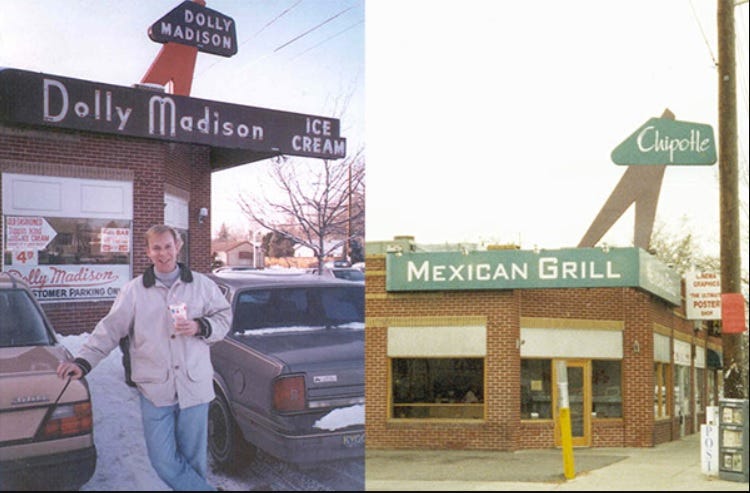"We Had Lines Out The Door"
“Growing the core McDonald’s business is our number one priority. At the same time, we know customers want - and are spending their eating-out dollars on - a variety of foods and dining experiences. So, we plan to supplement the growth of our core business and add shareholder value with a portfolio of Partner Brands - concepts that we believe will make a meaningful contribution to earnings over the next five to ten years.”
The first company added to the Partner Brands, as outlined in McDonald’s 2001 shareholder letter, was Chipotle Mexican Grill, a fast casual burrito chain with 13 locations at the time of their initial investment in 1998.
The Chipotle story starts in 1990, when 25-year old Steve Ells graduated from the Culinary Institute of America and moved to California to become a sous-chef at Stars working for Jeremiah Tower (“among the top-grossing restaurants in the U.S.”). After a few years, Ells decided that he wanted to bring his adaptation of the taquerias that were popular in San Francisco’s Mission District back home to Colorado. His vision became a reality on July 13th, 1993, when he opened the first Chipotle Mexican Grill in Denver, with help from an $85,000 “part loan, part equity” investment from his dad.
Ells, at the location of Chipotle’s first restaurant
In 1995, Chipotle opened its second location (“It did even better than the first one. We had lines out the door”). Over the next few years, Ells raised additional funds from friends and family to support the chain’s continued expansion (about $3.3 million total). At that point, it was already becoming clear that the concept had legs; consider this comment from Al Baldocchi, an early Chipotle investor with restaurant experience who has been on the board of directors since 1997: “What I saw that really surprised me was the unit economics. They were comparable to what some other public companies were producing, and that was [the data from] their worst store.”
But Ells was put off by the task of endless fundraising, so he set out to find a more permanent solution (“I really wanted a partner who could continue to invest year after year and help grow it”). In early 1997, Baldocchi reached out to a friend who ran business development at McDonald’s; shortly after, Ells made a trip out to Oak Brook, Illinois, where he prepared Chipotle’s menu for the McDonald’s board of directors (“The board just savored it.”).
Everything changed in February 1998, when the burger giant acquired a minority interest in Chipotle for roughly $50 million (a pittance compared to the $2.3 billion in pretax income it generated that year). Over the next seven years, McDonald’s invested about $360 million to support the continued growth of Chipotle, becoming its majority shareholder in the process (“By 2002, it owned more than 90% of Chipotle”). Ells was (apparently) amenable to giving up ownership in his business to supports its long-term growth - as long as the folks in Oak Brook didn’t try to tinker too much with his baby (“McDonald's seemed very interested in my passion about creating this brand. I trusted them, and they didn’t really interfere with the brand.”).
But while the arrangement had its benefits, particularly for Chipotle (“capital, distribution systems, real-estate expertise, construction knowledge, organizational structures, things like that”), it ultimately ran its course; simply put, as Ells would later admit, McDonald’s and Chipotle had “very, very different cultures”. (“McDonald's has a very strong franchise system, and their franchisees wanted Chipotle... but the economic model was so good that we wanted to own it [didn't want to franchise]. That was perhaps the biggest point of contention.”) One notable example of the contrast between the two companies was their limited product overlap: “There are 650 line items in a McDonald’s DC. When we brought Chipotle into the Portland DC, there was one common product that could either be delivered to a Chipotle or a McDonald’s restaurant: a five-gallon bag of Coca-Cola syrup. That’s it.” A bigger concern than supply chain efficiencies was strategic focus: in the mid-2000’s, the burger giant had a change of heart and decided to focus on its #1 priority – “growing the core McDonald’s business”.
As a result, in late 2005, McDonald’s announced Chipotle would go public (“We believe Chipotle’s value and potential might be maximized through alternative strategies that could include raising additional equity capital in public or private markets”). In January 2006, the company IPO’d at a price of $22 per share (the stock doubled on its first day of trading). At that point, McDonald’s still owned about two-thirds of the company; over the course of the next 18 months, they divested their entire stake in Chipotle (according to Ells, McDonald’s made ~$1.5 billion on their cumulative investment of ~$360 million). Once again, the burrito chain was set to chart its own course – and over the next 15 years, Chipotle would become one of the most successful companies in the history of the fast food / QSR industry.


